Constructing a Channel
|
How to: |
After you have defined the necessary channel conduits (inlet, route, and outlet), you can combine these conduits and construct a channel using the iWay Service Manager Administration Console. Every channel is required to have an inlet, a route, and an outlet.
Note: In terms of case-sensitivity, the naming of channels and channel conduits (inlets, routes, and outlets) is platform dependent. On Windows, which is case-insensitive, defining channels and channel conduits using the same name (for example, TEST and test) is not permitted. However, on case-sensitive platforms, such as UNIX, this is permitted. For example, on UNIX, you can create two separate channels named TEST and test.
Procedure: How to Construct a Channel
To construct a channel using the iWay Service Manager Administration Console:
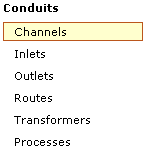
- In the
left console pane of the Registry menu, select Channels.
The Channels pane opens.
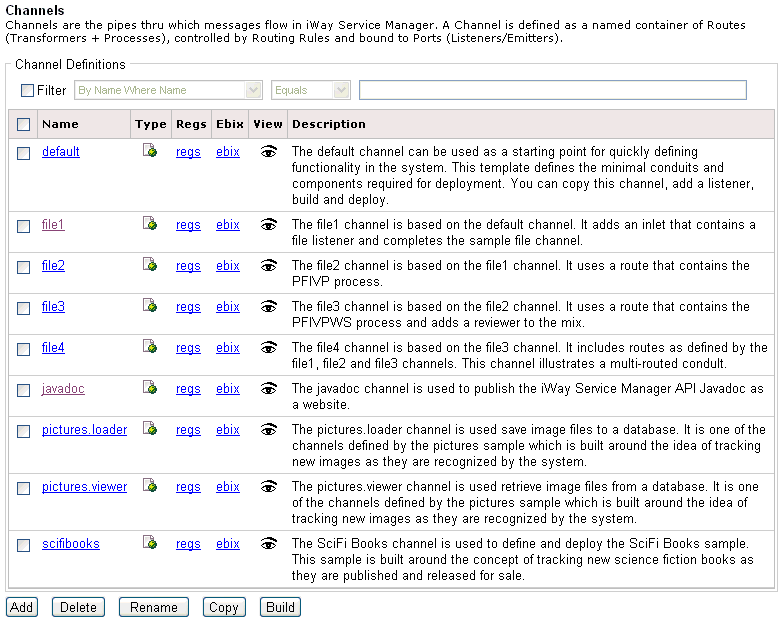
The table that is provided lists each channel that is defined with a brief description.
- Click Add.
The New Channel Definition pane opens.

- Enter a name, for example, SampleChannel, and description for the channel.
- Click Finish.
The Construct Channel pane opens.

The table that is provided is used to list the components that are currently registered with the channel.
- Click Add.
The Select component type pane opens.
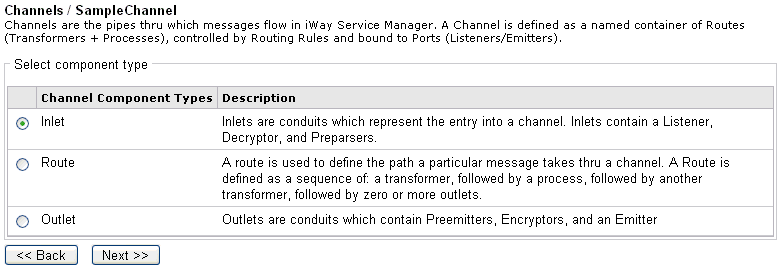
The table that is provided lists the component types you can select and register with the channel you are defining.
- Inlet - Conduits that represent the entry into a channel.
- Route - Used to define the path a particular message takes through a channel.
- Outlet - Conduits that consist of Preemitters, Encryptors, and Emitters.
- Select Inlet from
the list of component types and click Next.
The select an inlet definition pane opens.
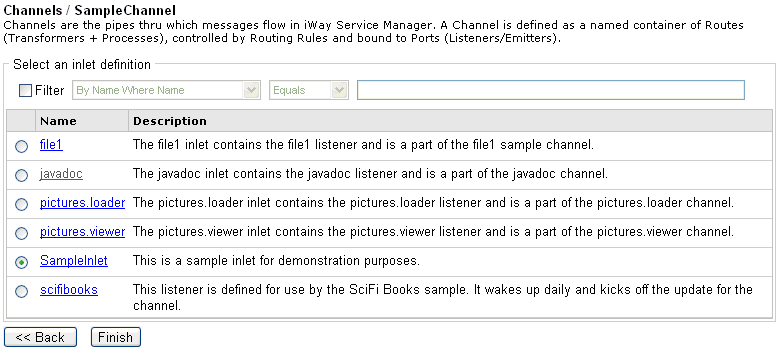
- Select
an available inlet, for example, SampleInlet, from the list and click Finish.
You are returned to the Construct Channel pane, which now includes the inlet (SampleInlet) you defined earlier.

You are now ready to add a route to the channel.
- Click Add.
The Select component type pane opens.

Notice that only the Route and Outlet component types are listed, since you have already added an inlet to the channel.
- Select Route from
the list of component types and click Next.
The select one or more route definitions pane opens.
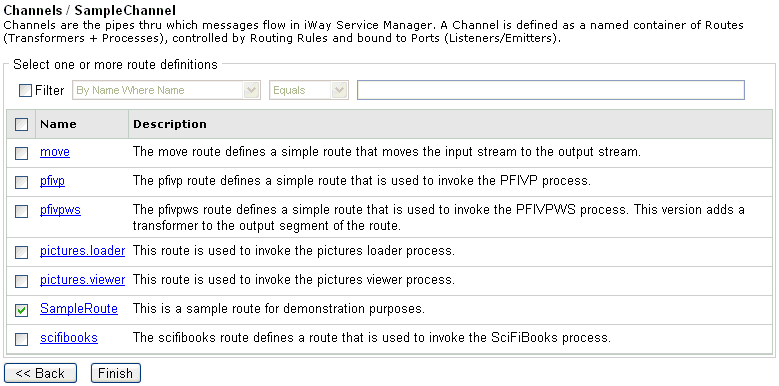
- Select
an available route, for example, SampleRoute, from the list and click Finish.
You are returned to the Construct Channel pane, which now includes the inlet (SampleInlet) and route (SampleRoute) you defined earlier.

You are now ready to add an outlet to the channel.
- Click Add.
The Select component type pane opens.

- Select Outlet from
the list of component types and click Next.
The select one or more outlet definitions pane opens.
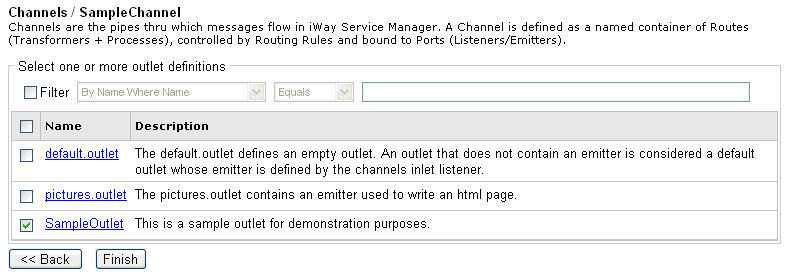
- Select
an available outlet, for example, SampleOutlet, from the list and click Finish.
You can assign multiple routes and multiple outlets to the channel.
You are returned to the Construct Channel pane, which now includes the inlet (SampleInlet), route (SampleRoute), and outlet (SampleOutlet) you defined earlier.

If you return to the main channels pane, you will notice that the channel you just constructed (SampleChannel) has been added to the list, as shown in the following image.
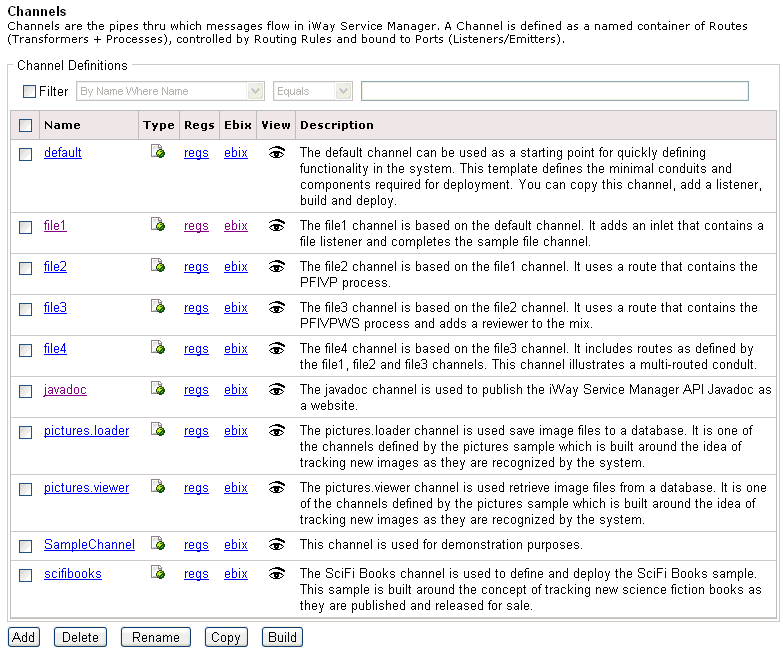
After you have designed your channel, you are ready to build and deploy it into a run-time environment. For more information on building, deploying, and repairing channels, see Operations and Monitoring.
Procedure: How to Modify a Channel
To modify a channel:

- Click
the channel name you wish to modify in the main Channels pane.
The Construct Channel pane opens.

The table that is provided lists all the channel components (inlet, routes, and outlets) that have been defined for that channel.
- Click
the name of the component, for example, SampleInlet.
The Construct Inlet pane opens.

The table that is provided shows the component that has been registered for the inlet. In this example, the file1 listener is used.
- Click
the name of the listener.
The Listeners pane for the file1 listener opens.
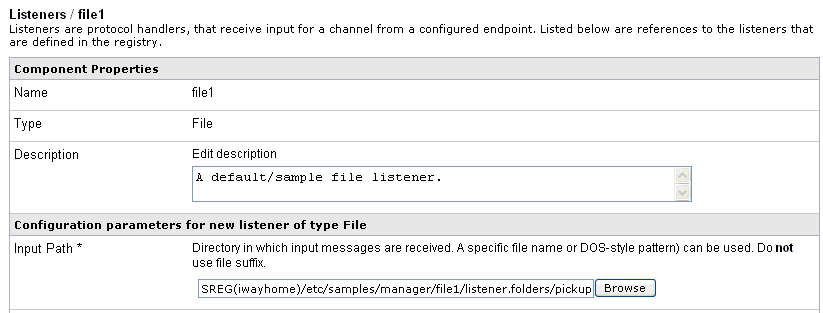
- Make
your changes to the listener properties as required and click Update when
you are finished.
The channel is now modified.
Procedure: How to Delete a Channel
To delete a channel:

- Click the check box next to the channel you wish to delete, for example, SampleChannel.
- Click Delete.
A confirmation dialog box opens, prompting you to confirm the deletion of the channel.
- Click OK.
The channel is deleted from the system.
Tip: To delete more than one channel at once, you can select multiple check boxes in the Channels pane and click Delete.
Note: Deleting a channel from the registry does not have any impact on deployed channels.
Procedure: How to Rename a Channel
To rename a channel:

- Click the check box next to the channel you wish to rename, for example, SampleChannel.
- Click Rename.
The Rename pane opens.

- Type
a name, for example, TestChannel, in the New Name field and click Finish.
You are returned to the main Channels pane.

The new name for the channel you provided is shown. If this channel has already been deployed into production, the prior name and version will remain in production until it is undeployed (see How to Undeploy a Channel).
Procedure: How to Copy a Channel
To copy a channel:

- Click the check box next to the channel you wish to copy, for example, SampleChannel.
- Click Copy.
A copy of the channel is made, as shown in the following image.

Making copies of a channel is useful for versioning and testing purposes.
Tip: To copy more than one channel at once, you can select multiple check boxes in the Channels pane and click Copy.